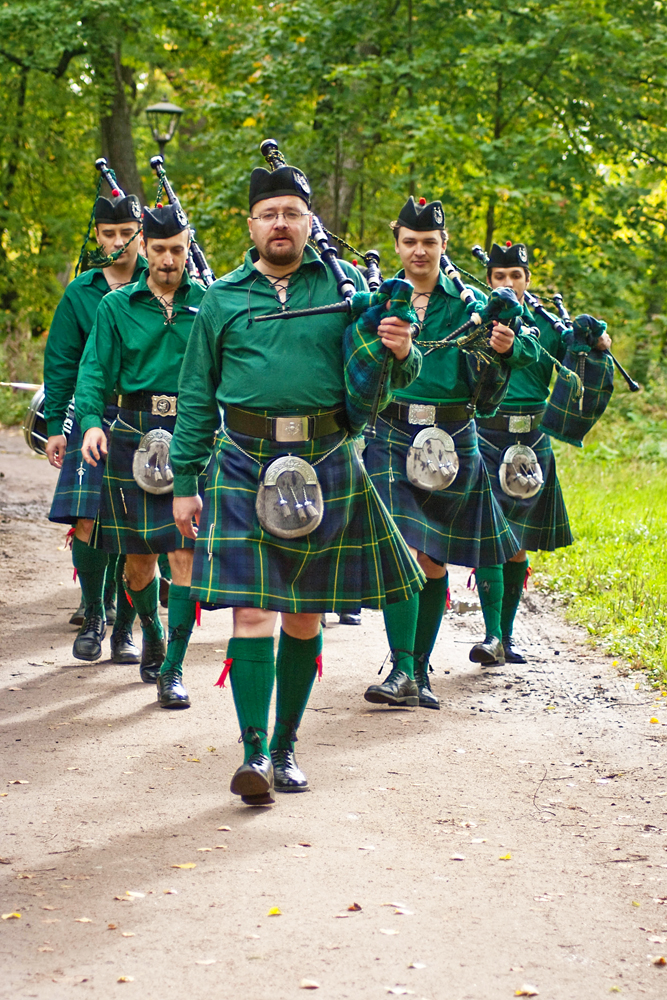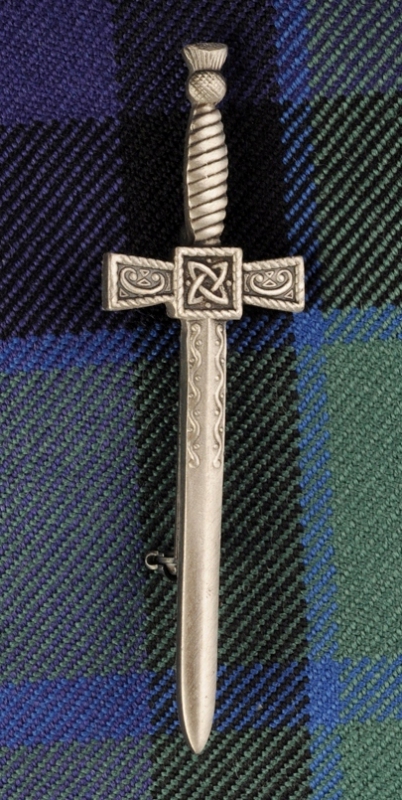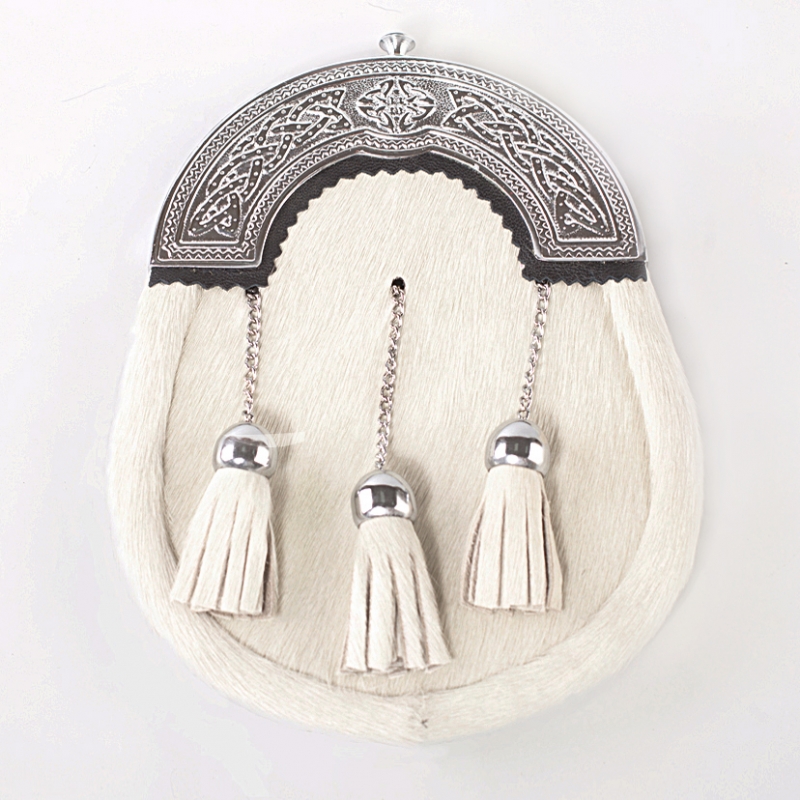 A Pipe Band usually performs in traditional Highland Dress and our band is not an exception. The main element of the dress is a check garment called a Kilt. The word «kilt» originates from Ancient Scandinavian «kjilt» (pleated) because the Vikings used to have similar pleated clothes. Kilt is made of woollen tartan cloth, the pattern of which denotes the clan of the wearer and his ancestors. Proud of their ancient traditions the Scots tend to say that «A man in a kilt is actually one man and a half».
A Pipe Band usually performs in traditional Highland Dress and our band is not an exception. The main element of the dress is a check garment called a Kilt. The word «kilt» originates from Ancient Scandinavian «kjilt» (pleated) because the Vikings used to have similar pleated clothes. Kilt is made of woollen tartan cloth, the pattern of which denotes the clan of the wearer and his ancestors. Proud of their ancient traditions the Scots tend to say that «A man in a kilt is actually one man and a half».
Unusual for the rest of Europe, this garment turned out to be very convenient in the Scottish Highlands. For running around the cliffs covered with heather, especially in rainy weather common for the region, kilt was very convenient as it gave freedom of movement and got dry very quickly, whilst for cold nights it turned into a warm blanket.
One of the descriptions dating back to 1746 states as follows: «This clothing is free enough and helps men used to it in passing through heavy obstacles, making quick moves, overcoming severe weather and crossing rivers easily.
The Kilt is adequately convenient for living both in the forest and under the roof. In other words, it remains efficient wherever the common clothing is not».
 The traditional “great kilt«{feilidh mor}is a square piece of tartan cloth about
The traditional “great kilt«{feilidh mor}is a square piece of tartan cloth about
Nowadays the word «kilt» usually refers to the small or walking kilt — the lightened variant of the ancient garment to have appeared in the first half of 18th century. The small kilt {feilidh beag}is actually the lower part of the great kilt with its aprons connected by two side belts while additional weight is added by decorative kilt pin worn on the upper apron and usually made in the shape of a claymore {claidheamh m?r} or any other Celtic or clan symbol.
Today the kilt is very often worn as a part of official or wedding dress. Kilts can always be seen around all the Highland Games as well as musical and dancing performances. In the British Army, as well as Commonwealth Forces, the kilt is still part of the traditional military uniform of the Highland Regiments, even though it is no longer worn in battle.
Not least as an important part of Highland Dress are the specially tailored «Argyll» and «Prince Charlie» jackets; long woollen hose; Balmoral and Glengarry bonnets; and a leather or fur purse called sporran.
 The Sporran is a purse worn around the waist, thus compensating for the absence of pockets on the kilt. Originally for keeping a handful of meal and other sundries in. They are usually made of leather, and decorated with fur or horse hair (depending on the uniform), with tops {cantles} made of different metal covers and decorated with Celtic patterns.
The Sporran is a purse worn around the waist, thus compensating for the absence of pockets on the kilt. Originally for keeping a handful of meal and other sundries in. They are usually made of leather, and decorated with fur or horse hair (depending on the uniform), with tops {cantles} made of different metal covers and decorated with Celtic patterns.
 It is interesting to note is that the sporran also performed a status function, reflecting its wearer’s rank in the clan he belonged to. As for the pipe band uniform, the idea is that while pipers wear it traditionally in the front, the drummers are to move it to the right side and return it to the front when they unfasten their drums.
It is interesting to note is that the sporran also performed a status function, reflecting its wearer’s rank in the clan he belonged to. As for the pipe band uniform, the idea is that while pipers wear it traditionally in the front, the drummers are to move it to the right side and return it to the front when they unfasten their drums.
 Highland Dress also includes wearing a sgian dubh (the Gaelic for «black knife») under his right hose.
Highland Dress also includes wearing a sgian dubh (the Gaelic for «black knife») under his right hose.
«Black», either because of its bog wood handle colour. or the idea of secret wearing. After the battle of Culloden in 1745 the English authorities forbade the Scots to wear any weapons therefore they had to use the smaller knife.
They had to hide their larger dagger called a Dirk. Eventually wearing it in the right hose has become a tradition, inserted from the outer side in peaceful time and from the inner side at wartime.
 The traditional footwear worn are «ghillie» brogues. These shoes date back to the Middle Ages when they were nothing but a piece of leather wrapped around the foot and fit on the calf by a long lace coming through holes made in that piece of leather. On the modern ghillie brogues those traits from the past are observed in the lace holes located on flexible leather cuts as well as the absence of shoe tongue. The decoration of holes on the front are a relic of the original brogues where the holes allowed the water to drain out from running over peat bogs.
The traditional footwear worn are «ghillie» brogues. These shoes date back to the Middle Ages when they were nothing but a piece of leather wrapped around the foot and fit on the calf by a long lace coming through holes made in that piece of leather. On the modern ghillie brogues those traits from the past are observed in the lace holes located on flexible leather cuts as well as the absence of shoe tongue. The decoration of holes on the front are a relic of the original brogues where the holes allowed the water to drain out from running over peat bogs.
The Scottish woollen bonnet also has an ancient history and tradition. Referred to as «Tam-o’-Shanter» after Robert Burns’s poem character it was first worn in the Highland Regiments, while the civilian type of it has always been called a «Balmoral». Later on the Regiments adopted a side-cap version called «Glengarry» — a Balmoral with the sides turned up — which along with Balmoral has become the most widely encountered among the pipe band uniforms. All usually decorated by either a regimental or clan badge (which quite often are the same).